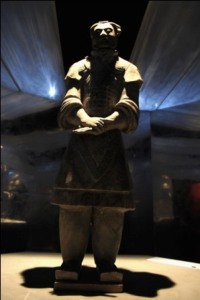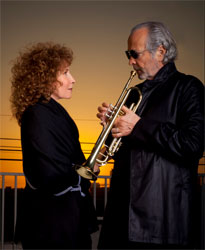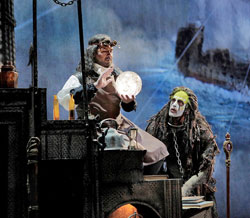Review: Terracotta Warriors: Defenders of China’s First Emperors
Spy: The Secret World of Espionage
Jun 7th

Thanks to Discovery Times Square, there’s a lot more to do in the theater district than just see a Broadway show. This massive space located in the former digs of the New York Times has played host to a series of fascinating exhibitions, with this summer’s diverse offerings being Terracotta Warriors: Defenders of China’s First Emperor and the rather more modern Spy: The Secret World of Espionage.
Unless you’re fortunate enough to be visiting China, Terracotta Warriors is the closest you’ll get to these magnificent figures that are more than 2,000 years old. Or, at least a tiny portion of them: The show includes only ten (the maximum allowed to leave China) of the some 8,000 life-size terracotta warriors, each weighing approximately 600 pounds, which were built for the tomb of the ancient Chinese emperor Qin Shiguangdi to protect him in the afterlife.
Buried with him in the second century BCE, they were only discovered by accident in 1974 by some farmers who were digging a well outside the city of Xian. A massive museum eventually sprung up to showcase them, although since then samples have toured museums throughout the world.
And now they’ve shown up in Times Square, in a beautifully laid-out exhibition that well showcases their ancient glory. The bright colors that once adorned the hyper-realistic figures have long since faded away. But as dramatically lit and presented here, they exert a compelling fascination nonetheless.
Representing various military ranks from generals to foot soldiers, this clay figures feature elaborate uniforms, unique facial expressions and, in one striking case, a life-size horse.
There’s much more to see as well. Brief film selections provide historical background information, which you’ll no doubt find illuminating unless you happen to be up on ancient Chinese history. The exhibition also includes over 200 artifacts from the period, many of which were originally buried with the warriors in the emperor’s tomb. They include a spectacular suit of armor, jewelry, musical instruments, a bronze ritual vessel, gold ornaments, and most notably, gates from an ancient Han burial chamber that is being displayed for the first time since its discovery.

The most appropriate attire for attending Spy: The Secret World of Espionage is a trench coat and fedora, the better to get you into the proper frame of mind for this fascinating show of objects relating to the world of espionage. Culled from the collections of the CIA, FBI, National Reconnaissance Office and especially the voluminous private collection of historian H. Keith Melton (author of such books as The Ultimate Spy and the forthcoming Spy’s Guide to New York City), the exhibition provides endless insight into the world of spies, largely through the tools of the trade.
Thus you’ll see such artifacts, many of them previously hidden, as a collapsible motorbike employed by Allied parachute forces in World War II; a dead rat with a hollow cavity used for dead drops in Moscow during the Cold War (hot pepper sauce was sprinkled on them to prevent them from being carried away by rapacious cats); a lifelike robot catfish, one of only two in existence; an Enigma Machine used by German military forces to create supposedly unbreakable codes; a STASI infrared attaché case equipped for covert photography; and a KGB model of the bugged US Embassy building in Moscow.
History buffs, albeit those of a ghoulish bent, will be thrilled to see the actual blood-stained axe used in the assassination of Leon Trotsky as well as the broken eyeglasses of his killer.
There are special sections devoted to such topics as homing pigeons that were used as couriers in World War II; U-2 spy planes, such as the one piloted by Gary Powers shot down by a Russian missile; and such recent infamous traitors as Aldrich Ames, John Walker and Robert Hanssen. There’s also special attention paid to Anna Chapman, the comely but amateurish Russian spy who achieved tabloid notoriety.
The show also includes cheesy interactive elements in which you can alter your own photograph and voice and dodge laser beams in Mission: Impossible style. And I’m not sure it needed to include a full-size recreation of the Oval Office. But these quibbles aside, Spy compellingly brings to light the gritty professional details of a milieu most of us know only from headlines and sensationalistic thrillers.
Discovery Times Square, 226 W. 44th St. 866-987-9862. www.discoverytsx.com. Terracotta Warriors through Aug. 26. Spy through Mar. 31.
Saturday, April 21, 2012
Apr 21st
Paul Simon collaborated with the Lincoln Center Jazz Orchestra in a revelatory concert featuring selections from his classic songbook. To read my New York Post review, click here.
------Frank Scheck
Review: Herb Alpert and Lani Hall
Mar 1st

Herb Alpert and his wife, singer Lani Hall, are delivering an evening of blissful nostalgia and superb musicianship at the Café Carlyle. Representing a rare concert appearance by the legendary trumpeter--and under wonderfully intimate circumstances at that--the show is not to be missed.
In the course of the relaxed proceedings, Alpert frequently takes the opportunity to gab with the audience. Admitting that at this point in his highly successful career—he was also the co-founder of A&M Records—he doesn’t need the money, he explains the real reason for his return to live performances: “I need the energy.”
And even at age 76, that energy is on ample display. Playing a muted trumpet, his instrumentals were as joyous and precise as they were fifty years ago when he burst into international stardom with the Tijuana Brass.
The evening showcases Alpert’s jazzier side, with many selections taken from the couple’s Anything Goes CD. Accompanied by a superb three-piece band, Hall, formerly the original lead singer with Sergio Mendes’ Brasil 66, lends her lustrous pipes to standards by the likes of Berlin and Porter as well as several Brazilian numbers. Her consistently powerful vocals on such songs as “Let’s Face the Music and Dance” and “Anything Goes” display as much emotional desperation as joyous defiance.
Alpert frequently sings too, to charming effect. He delivered a charming medley of “This Guy’s in Love with You” and “I’ve Grown Accustomed to Her Face” in a whispery but appealing voice that belied his protestation that “this is what you call chutzpah.” But it’s his instrumentals that truly shine, such as a Latin-style arrangement of the classic “Laura” and a “Night and Day” that amusingly included snippets of “If I Was a Rich Man.”
It’s when Alpert tapped into his hit-laden past that the audience truly swooned with delight. After a brief snippet from his monster hit, “Rise,” he performed a medley of Tijuana Brass favorites that was far too brief. Hearing his stirring trumpet on such classics as “The Lonely Bull,” “A Taste of Honey,” “Tijuana Taxi” and “Whipped Cream” was sheer baby boomer heaven.
“That was fun, I had a good time,” Alpert commented after the medley was done. So did we, Herb, so did we.
Café Carlyle, 35 E. 76th St. 212-744-1600. www.thecarlyle.com.
Review: The Enchanted Island
Jan 6th

For better or worse—depending upon your predilection--the Metropolitan Opera’s The Enchanted Island is the operatic equivalent of a juke box musical. This Baroque pastiche devised and written by Jeremy Sams uses the music of such composers as Handel, Vivaldi, Rameau, Purcell and a few lesser known luminaries to accompany a story that’s a mash-up of Shakespeare’s The Tempest and A Midsummer Night’s Dream.
Adding to the gala atmosphere of this production which appropriately premiered on New Year’s Eve, an all-star cast of singers has been assembled, including the great countertenor David Daniels as Prospero; Joyce DiDonato as the sorceress Sycorax (a character only mentioned in Shakespeare’s play); Danielle de Niese as Ariel; and no less than Placido Domingo as the god Neptune. Add to that Baroque master conductor William Christie in the pit and a spectacular production staged and designed by Phelim McDermott and Julian Crouch and you have a special event indeed.
Which is not to say that it is entirely successful--the appropriate elements have effectively been put into place, but to what end, exactly? Certainly, the storyline, even as swirled together as it is, is groaningly familiar, and the world has not exactly crying out for yet another Shakespeare adaptation. The music is indeed gorgeous, but--considering that Peter Gelb, the Met’s general manager, has been quoted as saying that he wanted to “play the Baroque card” but in a more streamlined fashion for modern attention spans--there’s far too much of it. Running three-and-a-half often lugubrious hours, this effort taxes the patience in a way that many original works from the period do not.
Still, there’s no denying the effort, ingenuity and imagination with which this concoction has been devised. Sams’ English-language libretto often displays great cleverness in its use of familiar melodies with freshly written words, and the selection of arias, apparently by Christie, should please both aficionados and relative newcomers to the genre.
While the silly storyline lacks any emotional heft whatsoever, it does have its amusing moments, such as the appearances by the old and cranky Neptune, wonderfully played by Domingo.
It’s the stagecraft that truly elevates the proceedings. Combining vintage 18th century techniques with state-of-the-art projections and animation, it displays a wit and imagination that makes the company’s behemoth productions of the Ring cycle seem hopelessly leaden. And these effects actually work.
Needless to say, with this stellar cast there is no shortage of great singing. Besides the aforementioned singers, there are superb contributions by Luca Pisaroni, looking like he just stepped out of Beauty and the Beast, as Caliban; Lisette Oropesa, charming and vocally crystalline as Miranda; and another terrific countertenor, Anthony Roth Costanzo, as Ferdinand.
For those unable to get to the Met, or afford those high ticket prices, be advised that The Enchanted Island will be broadcast in movie theaters nationwide Jan. 21 as part of The Met: Live in HD series.
Metropolitan Opera, Lincoln Center. 212-362-6000. www.metopera.org.
Review: Linda Lavin's CD Possibilities
Dec 21st

It’s only her first CD, but it’s safe to say that the kid’s a comer. Veteran actress Linda Lavin, whose long career includes extensive musical theater credits, has just released her debut recording, Possibilities (Ghostlight Records). The performer, best known for her starring role in the long-running hit television series Alice--and currently on a career role with successive acclaimed stage appearances in the off-Broadway production of Other Desert Cities, the Washington, D.C. production of Follies, and the recent hit play The Lyons—sparkles in this collection of pop and Broadway standards.
Featuring musical direction, arrangements and piano by cabaret/theater stalwart Billy Stritch (he also contributes vocals to “Corcovado”), the disc includes such classics as “It Might as Well Be Spring,” “It Amazes Me,” “In Love Again,” “There’s a Small Hotel,” and “Two for the Road.” Although Lavin’s voice is not the most powerful of instruments, her supple phrasing and sweet way with a lyric are consistently delightful.
The disc includes liner notes by director Hal Prince, with whom Lavin first worked a mere half century ago on the musical A Family Affair.